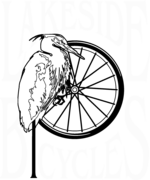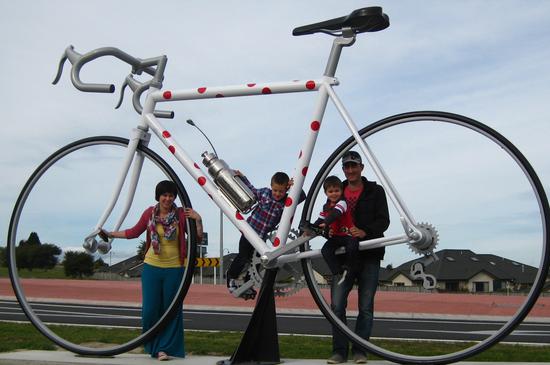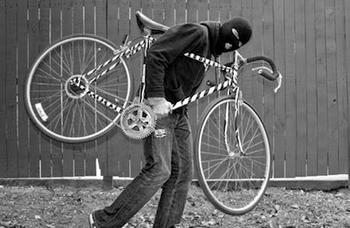
How To Buy Used Bicycles And Equipment
Buying used bicycles and equipment is a way to get bargains. Previously owned gear is often offered at fire-sale prices by sellers eager to move their, possibly hot, equipment quickly. However, we strongly recommend following a few guidelines to ensure that you don't get a lemon.
Inspect It:
Before considering any used bicycle, be sure to check for frame and fork damage. If these parts are flawed, run (don't) walk in the other direction. At best it will be costly to repair and it often indicates that the bicycle was abused, which will mean other serious and possibly life threatening 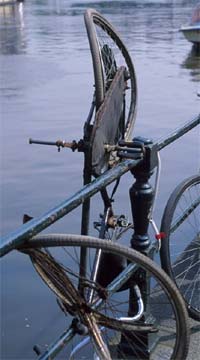 problems.
problems.
To inspect used bikes, look from the side and inspect closely the areas where the top and down tubes meet the head tube (the tube that contains the steering bearing). If you spot bulges or dents in these areas, the frame was probably crashed.
To tell if non-suspended forks are bent, look at the bike from the side. If the fork is good, an imaginary line bisecting the head tube will pass directly through the straight portion of the fork blade. For suspension forks, you may recognize damage sighting from the side. If the fork looks pushed back or overly extended, it could be bent. Also look for damage in the fork legs as you did inspecting the frame tubes.
Other telltale signs of frame damage include bent seat and chain stays and dents or cracks in the tubing. You can run your hands along the frame tubes feeling for dents. In the case of carbon fiber, a piece of gauze run across the tubes will catch on any loose fibers indicating hidden damage to the frame. Sight lengthwise along stays to spot problems. And, to find cracks, scrutinize the tube junctions.
While you're checking the frame be sure to look out for any corrosion problems. Rusted and corroded parts will be weakened, which can make a bike dangerous and result in expensive repairs.
After the frame and fork, check the wheels. Give them a spin and watch for wobbles and hops, which indicate damaged rims that will require repair or replacement. Check that the wheels are free of corrosion. And push and pull sideways at the top of the wheels to feel for play in the bearings, which might indicate broken axles and worn parts. To check more closely for these problems, you'll need to remove the wheel(s) and take a look at the hub(s) and hub bearings.
If the frame, fork and wheels pass muster, go over the rest of the components looking for signs of heavy use or abuse. If these items are worn, you'll have to replace or repair them before you can use the bicycle, which will add to your actual purchase price.
Parts, such as brake pads, cables and grips aren't costly, but if they are badly worn it may indicate a bicycle which has been generally poorly maintained. If the chainrings, cassette and chain are worn out, however, it can cost more to replace these parts than you might want to invest in the bike. An easy way to check drivetrain wear is to measure the chain. On a good chain, you can measure exactly 12 inches between two pins. If the measurement is 12 1/8 inch, or longer, you know that the chain is worn out and possibly the chainrings and rear cogs are as well.
It's easy to overlook a potential problem. So, if you don't feel comfortable inspecting the bike, ask the seller’s permission to bring the bike into Lakeside bicycles for a professional inspection. for a small fee our expert mechanics can verify that the frame is undamaged and that the components are in working order and the bike is worthy.
Get The Correct Size:
One tricky aspect of purchasing a used bicycle is getting the correct size. Bikes come in a wide variety of sizes and it may not always be obvious if you have the wrong one, which means that it's always best to double check size on any bike you're considering to make sure it's right for you. If it doesn't fit, no price is low enough.
Also, keep in mind, that Lakeside Bicycles provides a professional fit analysis. This will help fine-tune your bike fit and riding comfort to perfection and give you the measurements to check that used bike and make sure it's the right one for you.
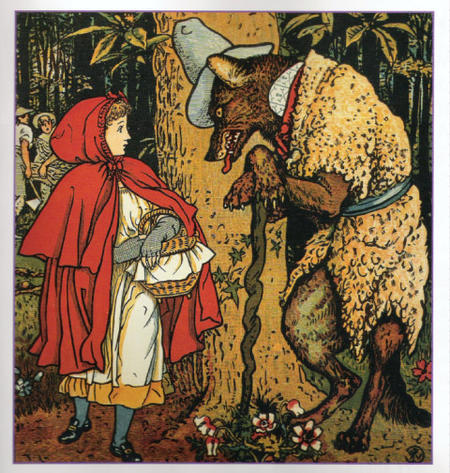
Buy Locally (heck, just buy a new bike from Lakeside Bicycles and avoid all of this)
No matter whether you're shopping for a bicycle, a new roof rack, a set of wheels or new shoes, there are significant advantages to buying from a seller who lives nearby. Buying from a local seller allows you to take home your gear the same day you purchase it. Should they cheat you it is always easier to hunt down a local seller, and even if they scarper they will usually have relatives living near by. Also, negotiations take place with an actual person so you can see if they really are a bereaved widow. Buying a used products is supposed to reduce costs (in order to offset any repairs). So why pay a penny more than you have to?
Buying a used bike is a way to get into bicycling and even to upgrade your equipment without paying full price. If you are confident of your ability to deal with the vagaries of buying uncertain products without warranty from complete strangers, go ahead. If, on the other hand, you prefer a modicum of confidence in the highly complex and potentially dangerous products you buy and the people who sell them, feel free to come by and let our friendly staff help you chose the perfect, fully warrantied and correctly fitted bicycle or accessory of your dreams.
